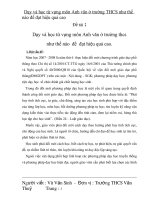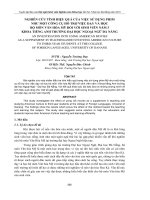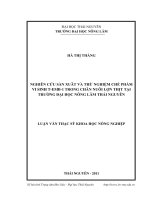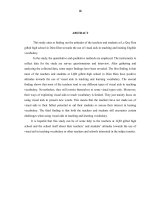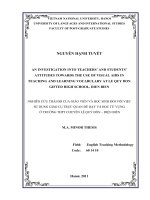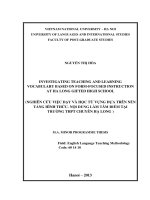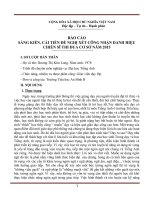Nghiên cứu việc dạy và học từ vựng dựa trên nền tảng hình thức - nội dung làm tâm điểm tại trường THPT Chuyên Hạ Long
Bạn đang xem bản rút gọn của tài liệu. Xem và tải ngay bản đầy đủ của tài liệu tại đây (650.4 KB, 60 trang )
VIETNAM NATIONAL UNIVERSITY – HA NOI
UNIVERSITY OF LANGUAGES AND INTERNATIONAL STUDIES
FACULTY OF POST-GRADUATE STUDIES
NGUYỄN THỊ HÒA
INVESTIGATING TEACHING AND LEARNING
VOCABULARY BASED ON FORM-FOCUSED INSTRUCTION
AT HA LONG GIFTED HIGH SCHOOL
(NGHIÊN CỨU VIỆC DẠY VÀ HỌC TỪ VỰNG DỰA TRÊN NỀN
TẢNG HÌNH THỨC- NỘI DUNG LÀM TÂM ĐIỂM TẠI
TRƯỜNG THPT CHUYÊN HẠ LONG )
M.A. MINOR PROGRAMME THESIS
Field: English Language Teaching Methodology
Code: 60 14 10
Hanoi – 2013
VIETNAM NATIONAL UNIVERSITY – HA NOI
UNIVERSITY OF LANGUAGES AND INTERNATIONAL STUDIES
FACULTY OF POST-GRADUATE STUDIES
NGUYỄN THỊ HÒA
INVESTIGATING TEACHING AND LEARNING
VOCABULARY BASED ON FORM-FOCUSED INSTRUCTION
AT HA LONG GIFTED HIGH SCHOOL
(NGHIÊN CỨU VIỆC DẠY VÀ HỌC TỪ VỰNG DỰA TRÊN NỀN
TẢNG HÌNH THỨC- NỘI DUNG LÀM TÂM ĐIỂM TẠI
TRƯỜNG THPT CHUYÊN HẠ LONG )
M.A. MINOR PROGRAMME THESIS
Field: English Language Teaching Methodology
Code: 60 14 10
Supervisor: NGUYÊ
̃
N THI
̣
BA
́
CH THA
̉
O, M.A.
Hanoi – 2013
iv
TABLE CONTENTS
Declaration
i
Acknowledgements
ii
Abstract
iii
Table of contents
iv
List of tables and figures
viii
List of abbreviations
ix
PART I: INTRODUCTION
1. Rationale
1
2. Aims of the study
2
3. Significance of the study
2
4. Scope of the Research
2
5. Research Questions
3
6. Method of the study
3
7. Design of the study
4
PART B: DEVELOPMENT
CHAPTER I: LITERATURE REVIEW
1.1. The Role of vocabulary in language teaching and learning
5
1.1.1 Definition of Vocabulary
5
1.1.2. The Importance of Vocabulary in Language Teaching and Learning
6
1.2. Approaches to teaching English Vocabulary
7
1.2.1. What needs to be taught while teaching Vocabulary
7
1.2.2. Methods and Approaches of teaching vocabulary at high school
10
1.3. Forms-Focused Instruction versus Form-Focused Instruction
12
1.3.1. Definition of Forms- Focused Instruction and its basic features
12
v
1. 3.1.1 Definition of Focus on Forms Instruction
1.3.1.2 Basic features of Focus on Forms Instruction
12
1.3.2. Definition of Form-Focused Instruction and its basic feature
13
1.3.2.1 Definition of Focus on Form Instruction
13
1. 3.2.1.1. Incidental Focus- on- Form
14
1.3.2.1.2. Planned Focus-on-Form
14
1.3.2.2. Basic features of Focus on Form Instruction
15
1.3.3. Advantages of Form-Focused Instruction over Forms-Focused
Instruction
16
1.3.4. Weaknesses of Form-Focused Instruction
17
1.3.5. Tendency of using Form-Focused Instruction in Language
Teaching
18
1.3.6. The summary
19
CHAPTER II: METHODOLOGY
2.1. Setting of the study
20
2.2. Participants
20
Students
20
Teachers
20
2.3. Data collection methods
21
2.3.1. Questionnaires
21
2.3.2. Interview
22
2.4. Data collection procedure
22
2.5. Data analysis method
23
CHAPTER III: FINDINGS AND DISCUSSIONS
3.1. Research question 1: What is the role of vocabulary in Language
Teaching and Learning at Ha Long Gifted School?
24
3.1.1. The Teachers‟ Attitudes toward the Role of Vocabulary and
Teaching Vocabulary at Ha Long Gifted School
24
vi
3.1.2. The Students‟ Attitudes toward the Role of Vocabulary and
Teaching Vocabulary at Ha Long Gifted School
25
3.2. Research question 2: How is vocabulary taught and learned at Ha
Long Gifted School?
27
3.2.1. The way that Vocabulary is taught and learned at Ha Long Gifted
School
27
3.2.2. Difficulties that the Teachers and Students cope with in teaching
and learning Vocabulary
33
3.3. Research question 3: What are suggestions for Teaching and
Learning vocabulary effectively?
35
PART C: CONCLUSION
1. Summary of findings
38
2. Implications
39
2.1. For Teachers
39
2.2. For Students
39
2.3. For Administrators
40
3. Limitations of the study
41
4. Recommendations for further studies
41
REFERENCES
42
APPENDICES
Appendix 1: Questionnaire for teachers
I
Appendix 2: Questionnaire for students
V
Appendix 3: Interview questions for teachers
IX
Appendix 4: Interview for students
X
vii
LIST OF TABLES AND FIGURES
Table 1: Purposes of teaching vocabulary at HLGS (TQ-Q2)
Table 2: Purposes of learning vocabulary of students at HLGS (SQ-Q2)
Table 3: Methods of teaching and learning vocabulary items (TQ-Q3&SQ-Q3)
Table 4: Aspects which teachers often choose when teaching vocabulary item (TQ-
Q8)
Table 5: Difficulties that the teachers face in teaching vocabulary (TQ-Q10)
Table 6: Difficulties that the students face in learning vocabulary(SQ- Q8)
Table 7: Reasons for students‟ preference of learning vocabulary in communicative
tasks or activities (SQ- Q10)
Figure 1: Teachers‟ attitudes toward vocabulary and teaching vocabulary (TQ-Q1)
Figure 2: Students‟ attitudes toward vocabulary and teaching vocabulary (SQ-Q1)
Figure 3: Frequency of teaching and learning vocabulary items separately or
isolatedly (TQ- Q4,& SQ- Q4)
Figure 4: Usefulness of teaching and learning vocabulary items separately or
isolatedly (TQ- Q5 & SQ- Q5)
Figure 5: Frequency of teaching and learning vocabulary items in communicative
activities or incorporating it in teaching four skills (TQ- Q6 & SQ- Q6)
Figure 6: Usefulness of teaching and learning vocabulary items in communicative
activities or incorporating it in teaching four skills (TQ- Q7 & SQ- Q7)
Figure 7: Teachers‟ presentation of new words (TQ- Q9)
Figure 8: Students‟ preferences of learning vocabulary(SQ- Q9)
Figure 9: Suggestions from students (SQ- Q11)
Figure 10: Suggestions from teachers (TQ- Q11)
viii
LIST OF ABBREVIATIONS
ALM : Audio- lingual method
CLT : Communicative Language Teaching
FFI : Form- Focused Instruction
FonF : Focus on Form
FonFs : Focus on Forms
GTM : Grammar- Translation method
HLGS : Ha Long Gifted School
L2 : Second language
Q : Question
SQ : Students‟ Questionnaire
TQ : Teachers‟ Questionnaire
1
PART I: INTRODUCTION
1. Rationale
English is a compulsory subject at all levels in the educational system in Vietnam.
However, the problems raised by the complexity and diversity of the English
vocabulary have driven all learners confused and discouraged. Thus, how to choose
an effective instructional method in teaching vocabulary is one of great concerns of
many language experts and English teachers myself included.
Vocabulary, as far as we know, is an important and pivotal component of a
language; thus, teaching vocabulary is also important. Nevertheless, it has not
received much recognition it deserves in the classroom at Ha Long Gifted High
school. The students here tend to think grammar is important but vocabulary is not
and they feel like learning grammar more than vocabulary.
There are many methods and approaches applied to teaching vocabulary; however,
choosing one way to teach new words effectively is not easy. When I studied for my
Master‟s Degree in TESOL, I was taught things like „communicative language
teaching‟, „methodology of English language teaching‟, „approaches to language
teaching‟, etc, and I really care about Form- Focused Instruction theory as it
emphasizes the importance of communicative language use and learner-
centeredness.
Another reason is that classroom setting especially that at high school is often
overlooked in favour of a more theoretical focus. As a teacher of English at a high
school, I want to comprehend more about applying Form-Focused Instruction
theory to English teaching with focus on teaching English vocabulary to high school
students. Thus, this study attempts to explore form- focused instruction in an ESL
classroom from the perspective of high school teacher cognition.
This study is conducted to investigate current situation of teaching vocabulary at Ha
Long Gifted high school. The study attempts to cast some light on the FFI theory in
vocabulary teaching that teachers find effective in practice and tries to draw some
2
implications for applying Form-Focused Instruction to improve teaching vocabulary
at Ha Long Gifted high school.
2. Aims of the study
The study aims at:
o Investigating the current situation of teaching and learning English
vocabulary at Ha Long Gifted School.
o Identifying the difficulties and obstacles that the teachers and students at Ha
Long Gifted School often cope with when teaching and learning vocabulary
based on Form-Focused Instruction theory. (Research Question 2)
o Making some recommendations for applying Form- Focused Instruction to
teaching English vocabulary effectively at Ha Long Gifted School.
3. Significance of the study
The study, once completed, will serve as part of continuous research on the teaching
of vocabulary with the intention to provide teachers of English at Ha Long Gifted
high school with a deeper understanding of applying Form-Focused Instruction- a
modification of Communicative Language Teaching- in teaching vocabulary.
In addition, it is hoped that the study will be of great significance in helping
students to be aware of their vocabulary learning problems; the teachers will also
benefit from the findings of the research in working out an effective way to assist
their students in communicative vocabulary learning.
4. Scope of the study
The notion of Form-Focused Instruction has been applied in teaching grammar,
pronunciation, speaking and writing. However, this study only investigates the
application of Form –Focused instruction in teaching and learning vocabulary.
Besides, due to the limited time and small scale of the research, it is only conducted
in the context of Ha Long Gifted High school with the participation of only 6
English teachers and 80 students.
3
5. Research questions
The research paper seeks answers to the following questions:
Research question 1: What is the role of vocabulary in language teaching and
learning at Ha Long Gifted School?
Research question 2: How is vocabulary taught and learned at Ha Long
Gifted School?
Research question 3: What should be done to apply Form-Focused
Instruction to teaching and learning vocabulary effectively at Ha Long Gifted
High school?
6. Methods of the study
Both quantitative and qualitative methods are used to carry out the research. First of
all, to form Theoretical Background for the research, theories, materials from
different sources including journals, books and internet are collected and analyzed,
synthesized and evaluated.
Then, survey questionnaire including open-ended and closed- ended questions is
used in collecting data for the study due to its unprecedented efficiency in terms of
research time, research effort and financial resources (Hoang & Nguyen, 2006:10).
While closed questions are useful for obtaining quantitative information and are
easier to analyze, open-ended questions can be useful for gathering qualitative
information and for discovering new variables in response. Thanks to survey
questionnaire, the researcher can collect a huge amount of information in a short
period of time and “with well-constructed questionnaire, processing data can also be
fast and relatively straightforward” (Gillian, 2000). Thus, there are two sets of
questionnaires employed. The first containing 11 open-ended and closed- ended
questions is for 80 students, the other containing 11 open- ended and closed- ended
questions is for six teachers at Ha Long Gifted High School.
The qualitative method is used in the interview. Semi-structured type is chosen
since “it gives the interviewee a degree of power and control over the course of the
interview […] and the interviewer a great deal of flexibility” (Hoang & Nguyen,
4
2006:45). Moreover, “the interactions are incredibly rich and the data indicate that
you can produce extraordinary evidence […] that you don‟t get in structured
interview or questionnaire methodology” (Dowsett, 1886: 53 cited Hoang &
Nguyen, 2006: 45). This advantage coincides with the researcher‟s purpose of using
this data collection instrument to clarify participants‟ responses as well as get
further information.
7. Design of the study
The research includes three parts:
Part A is Introduction in which, the rationale, the aims, the research questions, the
scope, method and the design of the study are identified.
Part B is Development
Chapter I is Literature Review, presents the theoretical background on which the
study is based.
Chapter II is The study which presents the methodology of the study, including
the background information of the context where the study is conducted, the subject,
the instruments used to collect data, and the procedures of data collection.
Chapter III is Findings and discussion, which deals with three research questions.
Detailed data description and analysis are presented and some explanation and
interpretations of the findings are given in this chapter.
Part C is Conclusion of the study, providing the summary and pedagogical
implications of the study. The limitations as well as some suggestions for further
research are also discussed in this chapter.
5
PART B: DEVELOPMENT
Chapter I: LITERATURE REVIEW
1.1. The role of vocabulary in language teaching and learning
1.1.1. Definition of vocabulary
Foley, J and Thompson, L in their book “Language learning: A lifelong process”
indicate that “all languages have words, a vocabulary or lexicon” (2003, p.10).
In Richards et all. (1992), vocabulary is defined as “a set of lexemes which includes
single words, compound words and idioms” (p.400). The term “vocabulary” has
also been viewed similarly by a few researchers, as “a collection of words”, “a
package of subsets of words that are used in particular contexts” or “total number of
words we know and are able to use” (Hornby et al. (1984); Nandy (1994) and
Jackson and Amvela (2000). Sharing the same opinion, Peny Ur states in his book
“A course in language teaching” that: “a new item of vocabulary may be more than
a single word”, it may be “a compound of two or three words or multi word idioms”
(Ur, 1996, p.60)
It can be seen that vocabulary is the total number of words of a language and it is an
essential part of language, as said by Plyes and Algeo “it is true that vocabulary is
the focus of language. It is in words that sounds and meanings interlock to allow us
to communicate with one another, and it is words that we arrange together to make
sentences, conversation and discourse of all kinds” (1970, p.96).
According to Fran Lehr, “vocabulary is knowledge of words and word meanings”
(Fran Lehr, 2004). It is true that vocabulary knowledge is something that expands
and deepens over the course of a lifetime. It is acquired incidentally through indirect
exposure to words and intentionally through explicit instruction in specific words
and word-learning strategies. Not only form but other aspects such as meaning and
usage should be taken into consideration in learning and teaching vocabulary.
6
1.1.2. The importance of vocabulary in language teaching and learning
Vocabulary is one of the elements of language that should be learned and taught. It
cannot be denied that it will be hard or even impossible to master a language
without understanding certain numbers of words and the importance of vocabulary
is summed up by David Wilkins: “Without grammar very little can be conveyed;
without vocabulary nothing can be conveyed” (Wilkins 1972: 111).
This point of view is echoed in the advice to students “If you spend most of your
time studying grammar, your English will not improve very much. You will see
most improvement if you learn more words and expressions. You can say very little
with grammar, but you can say almost anything with words!” (Thornbury, 2002,
p.13)
Krashen (as cited in Lewis, 1993) also confirms “when students travel, they don‟t
carry grammar book, they carry dictionaries” (Krashen in Lewis 1993: iii). Needless
to say, thus, vocabulary is an essential and important component of any language,
because “knowing words is the key to understanding and being understood. The
bulk of learning a new language consists of learning new words. Grammatical
knowledge does not make for great proficiency in a language.” (Vermeer, 1992:
147)
Vocabulary is basic to communication. It is necessary for successful and effective
communication for native speakers (Herbertson, 2003) as well as second and
foreign language learners (Alderson, 2005) since words play an important role in
expressing our feelings, emotions, and ideas to others during the act of
communication. Many researchers agree that lexis may be more important than
structure, because it is using wrong words and not wrong grammar that usually
breaks down communication. “Mistakes in lexis much more often lead to
misunderstanding and may be less generously tolerated outside classroom than
mistakes in syntax”. (Carter 1987: 145)
Vocabulary is a list of words, which means any unit of language used in all
conversations; thus, without a sufficient vocabulary, one cannot communicate
7
effectively or express his ideas in both oral and written form. It follows from this
that vocabulary is of great importance for real communication to take place.
Learning a language cannot be reduced, of course, to only learning vocabulary, but
it is true that “no matter how well the student learns grammar, no matter how
successfully the sounds of L2 are mastered, without words to express a wide range
of meanings, communication in an L2 just cannot happen in any meaningful way”
(McCarthy, 1990: VIII). For examples, in English teaching – learning process,
vocabulary is one element that links the four skills of listening, speaking, reading
and writing all together. A person with a limited vocabulary may find it difficult to
read and write well, hard to understand what others speak and fail to speak correctly
and idiomatically.
1.2. Approaches to teaching English vocabulary
1.2.1. What needs to be taught while teaching vocabulary?
Knowing a word implies knowing many things about the word- its literal meaning,
its various connotations, the sorts of syntactic constructions into which it enters, the
morphological options it offers and a rich array of semantic associates such as
synonyms and antonyms. These various aspects are related to the depth of word
knowledge which is as important as learning many words.
Once choosing what words to teach, it is also necessary to know what to teach about
each lexical item. There are many categories which can be taught to know the word
properly. Jeremy Harmer necessarily mentions that knowing a word does not mean
to understand only one of its meanings. According to him, there are four basic
aspects that students need to know when learning new vocabulary items: meaning,
word use, word formation and word grammar (Jeremy Harmer, 1991, p158)
8
(From Jeremy Harmer(1991), The practice of English Language Teaching,
p.158)
9
Nation (2001), however, proposes three basic criteria of knowing a word: knowing
its form, its meaning and its use. Following is Nation‟s description of truly knowing
a word:
According to Nation, “Knowing a word means knowing at least its forms, its
meaning and its basic usage” (Nation, 2001). This means that knowing a word
should not merely refer to knowing either the form or the meaning of the word.
Also, it should not ignore the aspect of being able to use the word accurately and
10
properly in a context. In other words, three aspects of form, meaning and usage
should be paid balance in teaching vocabulary.
1.2.2. Methods and approaches of teaching vocabulary at high school
According to Edward Anthony, an American applied linguist, “…an approach is a
set of correlative assumptions dealing with the nature of language teaching and
learning It describes the nature of the subject matter to be taught…” He also
confirms that “within one approach, there can be many methods…” (Anthony,
1963)
English is nowadays an international language, and English language teaching in
general and vocabulary teaching in particular have undergone dramatic changes
during the last two decades. In order to fully understand this development, it is
certainly worth giving a brief discussion of some major foreign language teaching
approaches and methods in teaching vocabulary.
The first approach is represented by the Grammar- Translation method (GTM). This
method “aims at inculcating an understanding of the grammar of the language and
training the students to write the new language accurately by regular practice in
translating from the native language…” (Rivers, 1981, p.29)
In this method, vocabulary is taught by means of translation when students are
given lists of words with their translation to be learned. Language is seen as a
collection of words which are isolated and independent and there must be a
corresponding word in the mother tongue for each foreign word students learn. In
term of the teaching of vocabulary, GTM focuses on meaning, assuming that word
meanings are easily learned; however, there is a lack of communicative activities
through which vocabulary is learned, consolidated and used appropriately.
The Audio – lingual method (ALM) represents the second approach. In ALM,
vocabulary is presented through dialogues. Most of the drills and exercises that
follow the dialogues are manipulative and pay no attention to content. In this
approach, the major objective of language teaching is to acquire the grammatical
11
and phonological structures of a language, thus, vocabulary learning is kept to a
minimum (especially in the initial stages) and new words are selected and
introduced directly. Vocabulary, nevertheless, is strictly limited and isolated from
context.
The third major foreign language teaching approach is the Direct Approach.
According to Freeman in Techniques and Principles in Language Teaching, “it was
revived as a method when the goal of instruction became learning how to use a
foreign language to communicate”. (Freeman, 1986, p.18). The main goal of this
approach is to train students to communicate in the target language and to have an
acceptable pronunciation. In this approach, vocabulary is emphasized over grammar
(Larsen- Freeman, 2000). Concrete words are taught through objects, pictures,
physical demonstration, and abstract words are taught by grouping words according
to a topic or through association of ideas (Zimmerman, 1997). Direct Method is an
answer to shortcomings of GTM; it focuses on communication, although oral
communication skills are just built by questions - answers exchanges between
teachers and students in small classes.
The Reading Approach focused on reading and writing skills. In this method,
vocabulary is controlled and the grammar which is relevant for the reading is
explicitly taught. Translation reappears in this approach as a respectable classroom
procedure related to comprehension of the written text, and “after a certain
vocabulary is reached, supplementary readers in the form of stories or simplified
novels are introduced, in order to enable the learner to consolidate his vocabulary”
(Mackey, 1978, p. 158).
While all of the traditional methods above were used to teach English for a long
time, the Communicative Approach has dominated the last several decades of this
century. According to Wikepedia: “Communicative Language Teaching is an
approach to the teaching of second and foreign languages that emphasizes
interaction as both the means and the ultimate goal of learning a language.
12
Communicative language teaching (CLT) helps learners be more active in real life
situations through means of individual, pair and group word activities. This helps to
enhance learners‟ communicative competence, manage their vocabulary and
develop their communicative skills at the same time as well as develop procedures
for the teaching of four language skills.
From the brief consideration of some approaches and methods to language teaching,
it is obvious that each of those has its strong and weak points. In terms of teaching
vocabulary, “There is no single method or approach that can work for all teacher or
for all learners or under all conditions because teaching is a socially constructed
activity” (Le Van Canh, 2004, p. 95). All of these approaches can be used for
teaching vocabulary so long as the teacher is aware of the relevant points of them.
1.3. Forms-Focused Instruction Versus Form-Focused Instruction
1.3.1. Definition of Forms-Focused Instruction and its basic features
1.3.1.1. Definition of focus on forms instruction
Focus on Forms (FonFs) Instruction, according to Long (1991), involves the pre-
selection of specific features based on a linguistic syllabus and the intensive and
systematic treatment of those features. In other words, FonFs instruction refers to
focusing on or teaching discrete lexical items out of context and isolated from
meaning as in structural syllabi (Long 1991 in Ellis et al. 2003: 149- 150). Thus, in
FonFs instruction, the primary attention is on the form that is being targeted in a
particular lesson rather than meaningful language use; and most of the lesson is
devoted to teaching L2 forms of which both teacher and learners are aware. In other
words, in FonFs instruction, vocabulary is taught in lessons separate from
communication or content, often following some kind of language syllabus. For
example, learners‟ attention can be drawn to words in non-communicative tasks as
in the case of matching words which are taught and listed in column A to their
definition in column B, or filling these words in given sentences, one word in each
sentence.
13
According to Ellis, Basturkmen and Loewen (2002), a good example of FonFs in
action is closely associated with PPP (presentation- practice- production) procedure,
involving the presentations of a linguistic feature, followed by first controlled
practice, and then free production. In FonFs instruction, language is treated as an
object to be studied and language teaching is viewed to be an activity to be
practiced systematically. Moreover, learners are seen as students rather than users of
the language (Ellis 2001: 14).
1.3.1.2. Basic features of focus on forms instruction
From above definitions, the criterial features of FonFs can be seen as follows:
the pre- selection of a linguistic target for a lesson
It means that the teachers can pre-select new words and some specific
features to teach. For example, teachers can pick up a list of the target
words in one unit and then give students their translation and
explanations.
awareness on the part of the teacher and students of what the
linguistic target for the lesson is
FonFs refers to the teaching of discrete linguistic structures in separate
lessons in a sequence determined by syllabus writers. It occurs when
vocabulary is taught as discrete units in the order of their linguistic
complexity. In this way, vocabulary is taught in accordance with a
synthetic syllabus. It involves language program planning based on the
syllabus that the teacher and learner know, thus, both of them are aware
of what to teach and learn.
1.3.2. Definition of Form-Focused Instruction and its basic features
1.3.2.1. Definition of focus on form instruction
Focus on form (FonF), in contrast, as defined by Long (1991: 45- 46) “…overtly
draws students‟ attention to linguistic elements as they arise incidentally in lessons
whose overriding focus is on meaning or communication”. Explaining how this
instruction could be implemented practically in the classroom, Long and Robinson
14
(1998: 23) stated that “focus on form often consists of an occasional shift of
attention to linguistic code features – by the teacher and/or one or more students –
triggered by perceived problems with comprehension and production”. Thus, with
respect to FonF instruction, the attention paid to form occurs or arises from a
communicative need; or the learner‟s attention can be drawn to lexical items within
a communicative task environment if these lexical items are necessary for the
completion of a communicative, or an authentic language task.
There is a distinction between two types of FonF instruction, namely incidental and
planned FonF.
1.3.2.1.1. Incidental focus-on-form
Incidental FonF refers to drawing learners‟ attention to the linguistic features that
arise occasionally during task-based activities in lessons that focus mainly on
communication or meaning conveyance. Incidental attention to form does not
predetermine what kinds of form should be taught. It occurs either as a result of a
communicative problem, when users do not understand each other, or when learners
want to focus on a form that has been used in communication, or in other words, the
forms which emerge from the communicative tasks performed in l2 classroom.
Incidental FonF can be pre-emptive; it means that the teacher or learners choose
specific forms to be the incidents of classroom discourse during meaning-focused
classroom activities. Pre-emptive incidental FonF is exemplified in some words that
are synonymous with different uses that confuse L2 learners.
1.3.2.1.2. Planned focus-on-form
Planned FonF refers to teaching specific L2 forms that hamper L2 learners‟
speaking and writing in a structured fashion. It is characterized by drawing learners‟
attention to specific forms in a single lesson (Ellis et al. 2003: 154). In planned
FonF, meaning is still mainly focused on, and the activities based on the enriched
input have a communicative focus, where the language to be learned is useful and
natural. This type of FonF instruction is similar to FonFs instruction in that a
specific form is pre-selected for treatment, but it differs from that the attention to
15
form occurs in interaction and the learners are not made aware that a specific form
is being targeted.
An important distinction between incidental FonF and planned FonF is that with
incidental FonF, various linguistic forms as grammatical, lexical, phonological and
pragmatic compete for the learners‟ attention; whereas, with planned FonF, the
teacher can select the linguistic form to which the learner should pay attention. This
distinction has importance implication for the effectiveness of the way L2 English is
taught in the classroom.
1.3.2.2. Basic features of focus on form instruction
Although there are many different opinions and definitions by many researchers or
authors; in the study, I choose the theory of Ellis in Ellis et al (1999) as basic
background.
Along the lines of Ellis et all. (1999), FonF has five critical features:
It is observable
FonF takes place interactionally, involves observable behavior, especially on
the part of teachers as they try to draw learners‟ attention to some formal
linguistic features. For example, to draw learns‟ attention to plural „s”, which
is usually missing from their speech, teachers can write „cars” and “radios”
on the board, underline the “s” in each case, pronounce both words with
exaggerated stress on the final sound and have learners repeat the words.
This way helps to increase learners‟ perceptions of target items; thus, more
important sense than the teachers‟ behavior is the learners‟ internal mental
stage.
It arises incidentally: FonF is employed only when a language learner‟s
need arises.
It occurs in discourse that is primarily meaning-centered
FonF involves strategies that draw learners‟ attention to the form or target
items within a meaningful context. Lexical items are taught within a
16
communicative task environment and learners need the opportunity to use
new linguistic forms communicatively and to engage in meaning-focused
language use.
It is transitory
In FonF, teachers do not dwell on the problem.
It is extensive. This feature of FonF instruction was added in Ellis et all
(2001a:441-442) It means several different forms are attended to in the
context of a single lesson.
In sum, the main differences between FonF and FonFs instruction can be listed as
followed in the table, according to Cheng Xiaotang, School of Foreign Language
and Literature, Beijing Normal University.
FonF
FonFs
- Form refers to language form in
general.
- Primarily focus on meaning.
- triggered by perceived problems in
comprehension or production.
- linguistic features are explored in
context
- forms refer to discrete, isolated specific
forms
- Primarily focus on form.
- pre-selected in the syllabus.
- Forms are taught in isolation.
1.3.3. Advantages of Form-Focused Instruction over Forms-Focused
Instruction
Many researchers confirm the advantages of form-focused instruction in language
learning. Foremost, according to Ellis et al. (2003: 150), focus on form contributes
to the development of learners‟ linguistic competence and ultimately develops
crucial communicative skills. It is obvious that learners need the opportunity to use
new linguistic forms communicatively and to engage in meaning-focused language
17
use. In FonF, linguistic elements are taught in communicative task environment. It
refers to attending to lexical units within a communicative and authentic task
environment when the lexical units are necessary for the completion of a
communicative task. It means that FonF allows meaning-focused interaction to
become a means for learners to acquire linguistic forms without necessarily placing
great emphasis on traditional grammar-based approaches.
Moreover, FonF helps to “involve learners, simultaneously, in attending to form,
meaning and use during one cognitive event” (Doughty, 2001, p.211). It is clear that
establishing connections between form and meaning is an essential aspect of
language acquisition. While FonFs instruction primarily focuses on form, it is in
FonF instruction that teachers can draw learners‟ attention to form, meaning and use
during a communicative activity; and this is the distinction of FonF instruction from
other pedagogical approaches.
In addition, FonF is possible and effective in raising learners‟ awareness of lexical
items and in facilitating immediate language use. Language features noticed during
communicative interaction may be more easily retrieved in communicative contexts,
and FonF occurs from students‟ needs in communicative tasks; thus, it is easier for
students to be aware of lexical features encountered in language use.
Last, but importantly, FonF helps to speed up vocabulary learning. The learners
have ability to use the targeted lexical items and recall them correctly particularly
when they incorporate the linguistic items into their production. This instruction
results in increased accuracy and accelerated progress through developmental
sequences.
1.3.4. Weaknesses of Form-Focused Instruction
Despite advantages of form- focused instruction, there are some limitations of it.
The first problem with focus on form instruction, according to Poole, 2003b, is class
size. FonF instruction seems to be suitable for classrooms that are small enough so
that teachers can address their students‟ problematic forms as well as frequently
evaluate students‟ performances. Also, students can have significant amount of peer
18
interaction both orally and in written form. Large classes may make individual
attention and student-student interaction impossible.
Another problem with FonF instruction relates to curriculum constrain. Practically,
at Vietnamese secondary schools and high schools, teachers are obligated to teach
certain forms in a specific order by using government-mandated materials. Because
of mandated curriculum, teachers may meet some difficulty in applying FonF
instruction; for example there is lack of time for each lesson, or the textbooks and
materials do not put emphasis on oral and written communication
The last limitation of this instruction according to Long (1991) and Long and
Robinson‟s (1998), is that, it requires teachers to have native-like or near native-like
competence language. It means teachers should possess a high level of L2
proficiency and would need to be able to spontaneously recognize students‟ form-
based errors and provide them with the correct ones. These are still big challenges
for Vietnamese teachers in different settings.
1.3.5. Tendency of using Form-Focused Instruction in language learning
Spada (1997a) concludes that form-based and meaning – based approaches need not
be in opposition to each other but can operate collaboratively. This seems to be the
most realistic current judgment which can be also seen in Littlewood‟s confirmation
of the tendency of combining focus on form instruction with meaning –based
instruction in teaching language, as according to him, the goal of foreign language
teaching is “to extend the range of communication situations in which the learner
can perform with focus on meaning, without being hindered by the attention he
must pay to linguistic form”. (Littlewood, 1981: 89)
In sum, nowadays, many interactions occurring inside the classroom will be neither
entirely form-focused nor meaning-focused but a combination of both. With respect
to that tendency, Nassaji (2000: 244) believes that the most effective way is “to
consider activities that result in attention to form while maintaining meaningful
communication and using form for communication”.

